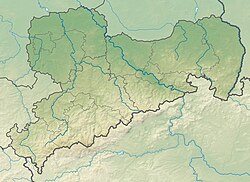
Back Парк Мужаковски Bulgarian Parc de Muskau Catalan Park Muskau Czech Muskauparken Danish Fürst-Pückler-Park Bad Muskau German Εθνικό Πάρκο του Μούσκαου Greek Parko de Muskau Esperanto Parque de Muskau Spanish Muskau parkea Basque موسکائو (بوستان) Persian
This article needs additional citations for verification. (April 2013) |
| UNESCO World Heritage Site | |
|---|---|
 | |
| Location | Bad Muskau, Görlitz, Saxony, Germany, and Łęknica, Żary County, Lubusz Voivodeship, Poland; Historic region: Upper Lusatia |
| Criteria | Cultural: (i), (iv) |
| Reference | 1127 |
| Inscription | 2004 (28th Session) |
| Area | 348 ha (860 acres) |
| Buffer zone | 1,204.65 ha (2,976.8 acres) |
| Website | www |
| Coordinates | 51°33′01″N 14°43′36″E / 51.55028°N 14.72667°E |
Muskau Park (German: Muskauer Park, officially: Fürst-Pückler-Park Bad Muskau; Polish: Park Mużakowski) is a landscape park in the Upper Lusatia region of Germany and Poland. It is the largest and one of the most famous English gardens in Central Europe, stretching along both sides of the German–Polish border on the Lusatian Neisse. The park was laid out from 1815 onwards at the behest of Prince Hermann von Pückler-Muskau (1785–1871), centered on his Schloss Muskau residence.
In July 2004, Muskau Park was added to the list of UNESCO World Heritage Sites (as a joint effort between Poland and Germany) because of its 'utopian' design that incorporates both native plants and the nearby town, and its influence on the development of landscape architecture.[1] The park also stands as one of Poland's official Historic Monuments (pomnik historii), as designated on May 1, 2004, and tracked by the National Heritage Board of Poland.
- ^ "Muskauer Park / Park Mużakowski". UNESCO World Heritage Centre. United Nations Educational, Scientific, and Cultural Organization. Retrieved 2 September 2022.


